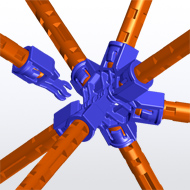 |
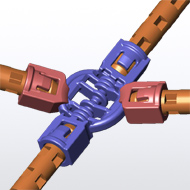 |
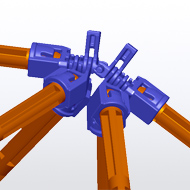 |
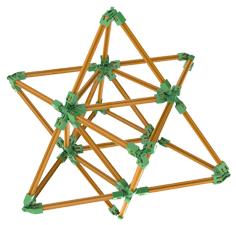
The PolyLinx™ System – How It Works
Young and old creators can grab a handful of pieces, snap them together, and start building awesome things. Understanding “how it works” is not necessary for designing, building and having great fun with PolyLinx. But, if you really want to know…
PolyLinx is a hub and strut construction set. Hubs and struts are the elements that make up the Eiffel Tower, bridges around the world, molecular lattices, and geodesic domes. These kinds of structures, as well as many others, aren’t built around the fixed 45 and 90 degree angled hubs offered by existing construction sets.
Some structures are hexagonal based and require 60 and 120 degree angles. Pentagons follow a 108 degree design pattern; the inner face to face angle of the dodecahedron is 116.56 degrees. The angles between the struts on even simple geodesic domes make up a complex range of values. PolyLinx is designed so that users can build with any angle they want. Fortunately, for the casual builder, knowledge of these angles is not required. Natural geometric constraints dictate the relationships as the user simply snaps together a 3-dimensional star, for example.
All of the hub pieces are designed to be mixed and matched, snapped together in one combination for building some fantastic creation, then later snapped together in some other permutation for creating something totally new. Because of this modularity and angular flexibility, PolyLinx can form new models and structures that have not been possible before.
Elements listed below are only representive of range of a PolyLinx elements. A more complete list of PolyLinx parts can be found here (pdf). A preliminary model construction guide can be found here (pdf), which demonstrates how PolyLinx may be assembled into full scale models.
-------------------------------------------------------------------------------------- |
|
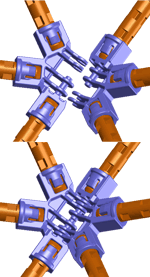 |
At the heart of PolyLinx is the patent pending Hinge-Hub™. The primary Hinge-Hub is constructed of two matching half-hub elements, incorporating a symmetrically designed hinge surrounded by slots with which to connect struts. Struts attached to the two halves may then be adjusted to a continuous range of angles between them as each section revolves around the hinge’s primary axis. Using only this primary hub and a handful of struts, one may build a wide range of polyhedra, nanotubes, and other structures. |
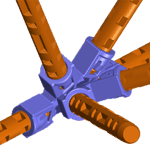 |
As demonstrated at left, the hinge-hub is designed to accommodate very tight angles, more than that possible by potentially competing solutions. |
-------------------------------------------------------------------------------------- |
|
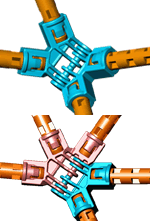 |
In some instances, structures do not require the primary slots -- those slots residing along the "primary axis". In this case, a hub may be constructed using butterfly elements, resulting in the butterfly hub or one of many differing mixed element hubs. Using a butterfly combination in lieu of a Hinge-Hub with an extraneous primary axis can result in an aesthetically pure, elegant structure. The butterfly hub may be mixed and matched the the full hub elements. |
-------------------------------------------------------------------------------------- |
|
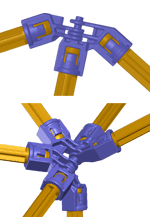 |
Split-hub elements provide further flexibility in design, allowing the user to create models without using the full hub. Essentially, it is a half-hub element, sliced in two. It still mates with the half hub, but now, some struts can rotate one way, others, another way. Due to the symmetric design of the hinge, these upper and lower split hub elements can be paired with themselves. In this configuration, the split hub can be used as the vertices (corners) in a tetrahedron (three sided pyramid), or at the ends of a nanotube. |
-------------------------------------------------------------------------------------- |
|
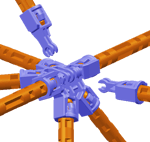 |
Gaps along the primary hinge allow for the additional struts to be attached providing even more angles and structural flexibility to one’s design. The use of this can be seen in our PolyStar (stella octangula). When added to the slider hubs, discussed later, 3D lattice structures such as the space tessellated rhombo-hexagonal dodecahedron (whew!) can be constructed. A single 90° secondary slot is shown; though these additional slots can come as multiples, at other angles, and as slider slots. |
-------------------------------------------------------------------------------------- |
|
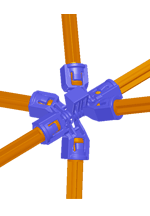 |
With the addition of the split-clip, two independent sets of split-hubs may be connected to each other, allowing each quadrant of slots to revolve independently of the other about the primary axis of the hinge-hub. As with other variations of the primary Hinge-Hub, the split-clip feature offers different ranges of motion for building complex structures. For example, the icosahedron in the Polylinx Primer Kit requires the split clip to satisfy the various angle requirements simultaneously. |
-------------------------------------------------------------------------------------- |
|
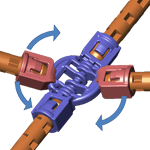 |
For additional flexibility, the slider hub and slider slot can be used. Slider slots are snapped onto a semi-toroidal ring (inner-tube shape) on the hub. Multiple slots can then be positioned on this ring about an axis orthogonal to the primary axis. As in the primary hub, due to the symmetric design of the primary hinge, two identical slider hub elements make up a single complete slider hub. Like the primary half-hub and its variations, the slider hub is available in split forms and forms without the primary slot. These pieces can be mixed or matched both among themselves and with the non-slider elements. Multiple split slider hubs can also be connected using the split clip, giving the user nearly unlimited freedom of relative placement of struts connected to it. |
-------------------------------------------------------------------------------------- |
|
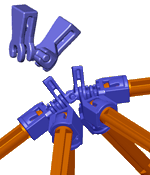 |
The hinge clip is used where the split clip might also attach, but it provides an additional axis of rotation orthogonal to those axes provided by the primary axis and the axis of the slider hub. With this additional element, everything from geodesic domes to complex space lattice structures can be built. |